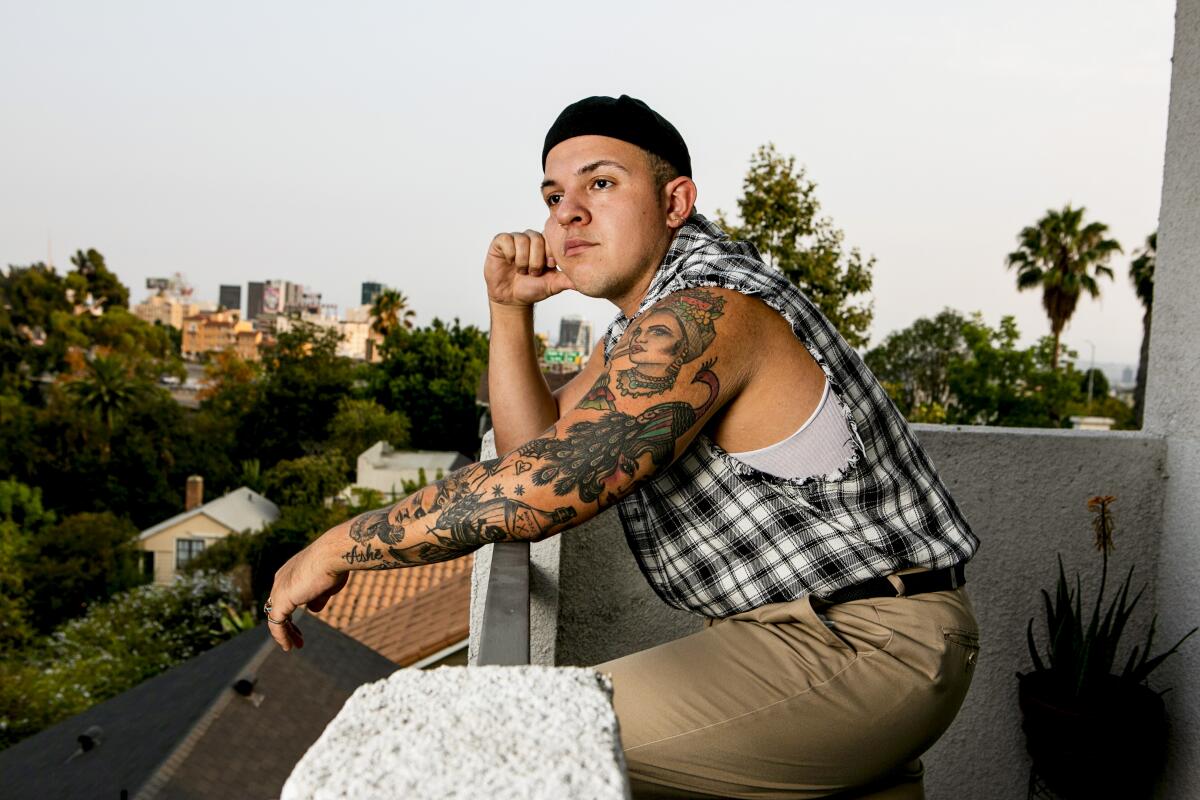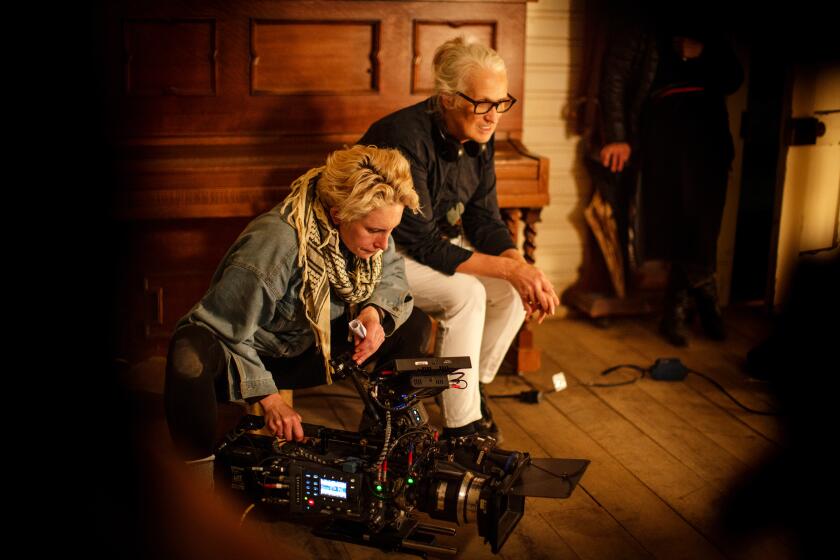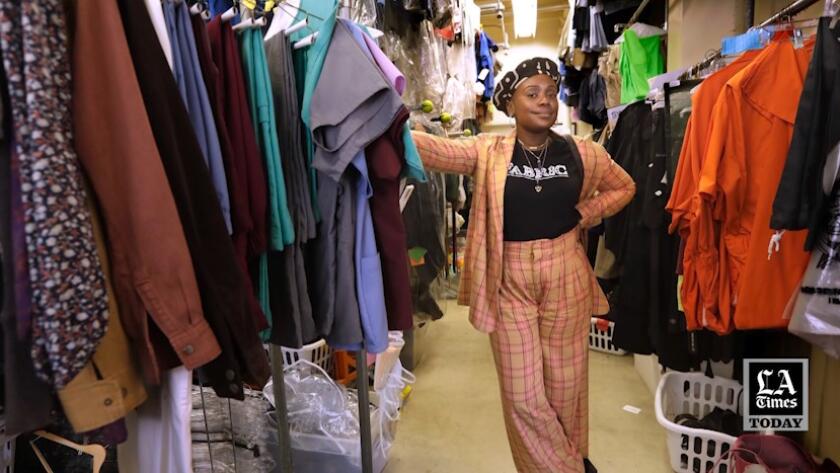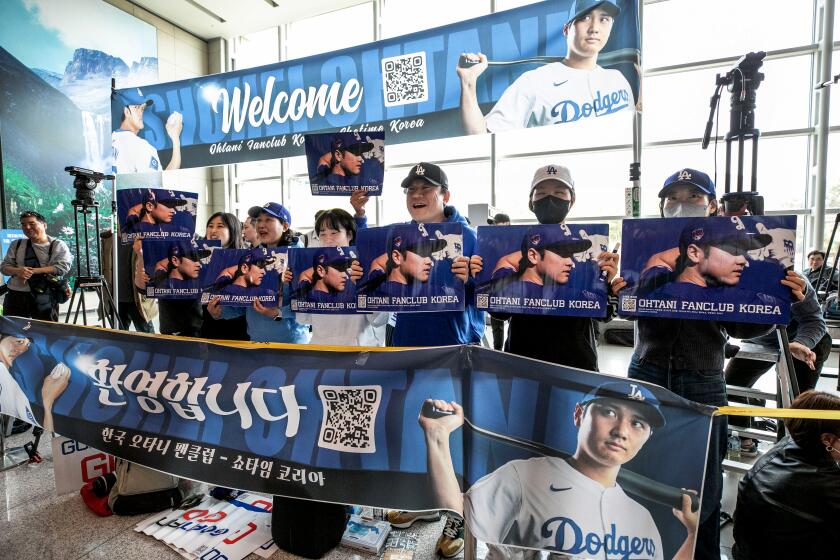A Hollywood union tried to promote diversity. Then things got complicated

On a Wednesday afternoon nine days after the murder of George Floyd, Brittny Chapman sat down in front of her iPad camera in her East Hollywood apartment and pressed record.
With round, gold-rimmed glasses framing her face and a black T-shirt blazoned with “Black Women Welcomed,” the 36-year-old costumer chastised her union’s muted response to the worldwide protests following Floyd’s death in 2020.
Studios such as Netflix and Walt Disney had pledged financial support for Black lives and social justice. Chapman’s Motion Picture Costumers Local 705, which represents thousands of Hollywood costume workers, had shared tweets by parent union IATSE expressing solidarity with African Americans but otherwise was quiet, she complained.
In an Instagram video viewed thousands of times, she said:
“I don’t think y’all get what I face every day when I’m on set and that’s alarming to me. Instead of standing with me, maybe figure out ways that y’all can show up for all of us, maybe start creating programs where you’re reaching out to our community to be a part of our unions because I’m just going to say, I would really like to see more of us behind the camera.”
Within two weeks, Chapman was recruited to help lead a new diversity committee for Local 705. The committee set lofty goals and recruited diversity consultants.
But just four months later, she and the three committee co-chairs of color resigned in protest, questioning the union’s sincerity about achieving diversity.
The story of what happened when costumers tried to instigate reform is a tale of the frustrations and barriers to progress that exist in many Hollywood unions. But it also offers glimmers of hope.
Last year members elected the local’s first Black president and its most diverse board.
Former Local 705 President Nickolaus Brown conceded that the union could have done a better job of addressing the concerns of committee members, but he said the local had taken important first steps.
“This is so entrenched in the fabric of this industry and our local and it’s not going to be fixed in three months,” Brown said. “It is going to take a lot of work, a lot of focus and a lot of genuine caring and shepherding of making those changes.”
Following the protests over the killing of Floyd, major studios faced greater scrutiny of their commitment to diversity, equity and inclusion. Many announced initiatives to hire more from marginalized groups to produce or direct film and TV. But the crews that produce this content remain overwhelmingly white and are still grappling with the effects of chronic underrepresentation.
“I’ve been on sets and behind the camera it’s usually completely white,” said Darnell Hunt, professor and dean of social sciences at UCLA. “This is reflective of a culture that has excluded people of color. There are improvements in diversity in front of the camera, but we are not seeing the same effort to diversify below the line.”
A new study shows women are getting more work as film directors, but the percentage of female directors of color has remained unchanged the last 15 years.
The International Alliance of Theatrical Stage Employees (IATSE), the umbrella union for Local 705 and other below-the-line workers, spent much of last year in strained negotiations over a new contract with Hollywood studios.
As part of a deal to avert a strike, producers agreed to make Martin Luther King Jr. Day a paid holiday and to form an internship program for underrepresented workers.
Local 705 already had confronted racism in its ranks. In 2019 IATSE expelled a white female costumer member of 705 after she was caught on camera in a racial-slur-laden rant at an Eagle Rock CVS.
Chapman joined Local 705 six years ago after moving to L.A. from New York, where she graduated from Pace University with a degree in communications and sociology. The Philadelphia native experienced racism on sets long before posting her impassioned video last summer.
“There’s no reason that I should be pulling up to a [film] set in my car and security is asking me what am I doing there,” Chapman said in the video.

Local 705’s leadership tried to quickly address the criticism. The union declared on social media that it didn’t tolerate racism and welcomed diversity.
Then Brown, the local president, asked Chapman to chair a new diversity committee. Brown also invited fellow 705 member and costume designer Lynn Ollie to be co-chair.
They, in turn, invited colleagues as co-chairs: Laura Wong, who had experience working on union committees, and Edward Garcia, a young costumer who had his own reasons for getting involved.
Garcia, 29, said that he has been followed around in luxury stores by retail staff because of his appearance — young, Latino and tattooed. He drives a Chevy Trax, which he describes as a “suburban mom” car, in part to avoid drawing suspicion when shopping for costumes in affluent neighborhoods.
While working on a TV show in 2018, Garcia said, the costume designer he reported to threw clothes at him and called him “her little brown boy.”
“You get put into those situations and you kind of think that this is how it is,” Garcia said. “At this point in my career, I would never let anybody speak to me like that.”
The diversity committee had its first public meeting on June 28, 2020. Throughout the summer, the local showed support for marginalized groups, promoting Juneteenth and Black-owned brands for costumer resources.
Within its first weeks, the nascent committee drew 50 members and published a list of objectives that were supported by the executive board, a group of elected officials from the membership.
Even before the committee met for the first time, by June 15, 2020, the local said on Instagram the board approved funding for two unconscious bias classes and listed the committee aims, including forming mentoring groups, showcasing diverse members via social media, and creating safe spaces or ways for members to raise concerns at work and in the union.
The goals included hiring a diversity consultant for the local, reinstating an anti-bullying amendment that was voted down by members in April 2019, and conducting an anonymous survey of the membership’s racial demographics — a key first step in any reform effort.
Delays over a survey of members
But delays with the survey frustrated Chapman.
The union hired a consulting firm in July to draft survey questions, but they weren’t sent to members until Oct. 10, Chapman said. Chapman said union leaders ignored emails she sent seeking guidance about the survey during that period.
Another issue for Chapman and other committee members: The union’s leadership rebuffed a request to translate their materials into Spanish and other languages. Local 705 represents blue-collar crafts like sewing, and many costumers are first- or second-generation immigrants. The committee had wanted to provide the survey in different languages.
“The answer became no because it was too difficult,” said Adam West, a former field representative for Local 705 who is now its business representative. “We’re trying to remedy that and move forward with more translation.”
Some committee members said they faced harassment. One committee member, who asked not to be identified for fear of retaliation, said another union member posted messages on social media suggesting they were engaging in reverse racism.
The volunteers also objected to being asked to find diverse crew members. Garcia recalled that a month after the committee formed, a crew member for a TV show set in Afghanistan wanted help finding a costumer of Afghan descent. No specific skill or knowledge was asked for.
“Making a specific nationality or ethnicity the only prerequisite for hiring is a problem in itself,” Garcia said. “Based on this practice, I might only get hired to costume on shows involving L.A. or something specific to my family’s country of origin.”
Garcia, who is Afro/Indigenous, Cuban and Mexican and grew up in the San Gabriel Valley and Santa Clarita, is largely self-taught and got his start in costuming by styling celebrities.
At first, Garcia said, he was energized by his role on the diversity committee, but soon he felt weighed down by having to repeatedly explain what costumers of color endure.
He recalled how on one TV show a supervisor told him he should not speak Spanish because it made crew members uncomfortable. He declined to name the show or those involved for fear of retaliation.
“That became exhausting to constantly have to relive the traumas that we face as part of working as people of color in the industry,” Garcia said. “Every day I’m trying to convince people that this stuff is real, and I’m also, like, then experiencing it on a day-to-day basis as well.”
Another of the four co-chairs, Wong said she felt tokenized in the role.
“It was toxic, I had to quit,” said Wong, a costumer on such shows as “Star Trek: Picard.” She shared her own experiences with racism on sets in an essay published in LAist last year.
“It’s really difficult to volunteer your limited free time for this work when you feel like you have no support,” Wong added. “I became the token Asian for every diversity issue and felt like I was being asked to speak for every Asian person.”
Tensions came to a head in September 2020 when Chapman and her colleagues raised concerns with the executive board.
“After openly expressing that we felt we were being burdened with a lot of the work and the executive board wasn’t being active enough, we were told by someone that they are ‘sorry our feelings are hurt,’” Chapman said. “That statement cut into me and cemented that I no longer wanted to keep showing up and working to help dismantle a system that I never built and that I have repeatedly been a victim of.”
The four co-chairs resigned in October and were eventually replaced by other committee members.
“Despite persistent calls to action, the leadership of Local 705 continues to show little investment in interrogating or dismantling the antiquated and racist systems,” the four co-chairs wrote in an email to the executive board. “The work that has been done has at various times felt forced, performative, insincere, and treated like an inconvenience. After calling out inaction or poor conduct, we have either been ignored or experienced backlash and retaliation.”
They said they had planned to stay in their roles until the survey was launched and the resulting report, they hoped, would lay the groundwork for systemic change at the local, they said.
But it took a year — until October 2021 — before the diversity survey results were shared with members, a delay union officials chalked up to the pandemic, elections at the local, technical issues and contract negotiations.
The survey, conducted by consulting firm Twenty45 Consulting, had a low response rate. Only about 498 of the guild’s 2,400 members participated. The results underscored the union’s lack of diversity: 72% of the respondents identified as white.
Only 14% identified as Latino or Hispanic — compared to nearly 50% for Los Angeles County —11% as Asian, 9% as Black, 5% as Native American or Alaska Native and 4% said some other race or ethnicity. About 2% declined to identify.
Brown, who had been in his second term as president of 705, also a volunteer role, conceded he was not fully focused on the crisis facing his colleagues of color, citing personal reasons and the pandemic.
“My best friend died two days after George Floyd’s murder; I was checked out,” Brown said. “I’m not saying that’s a pass, it’s not, but that’s where my head was.”
He added: “Members were really upset and worried about COVID and what it meant for them to go back to work. That was our main focus. Am I disappointed in our response, lack of response? Absolutely. Did give we try and step up and do everything that we could to make positive change? I tried my hardest.”
Brown said the that the union, along with quickly establishing the diversity committee in June of 2020, created a position on the executive board for a diversity advocate. The local also recruited members of color through an outreach program to local schools. After the co-chairs resigned, Brown said the local hired a salaried person to help committees do their work.
Part of the responsibility also lies with producers, Brown said, noting the absence of mandatory training for crews about racism.
“They create a class to teach everybody about COVID, it happens in record time. But racism is endemic in this business and how come we don’t have a class about racism and microaggressions?” he said. “All of us, every local, has work to do. But so do the producers.”
A brighter future
Despite the setbacks, other members were brought in to replace Chapman, Ollie, Garcia and Wong. The work of the committee continued and sparked even greater change in the union — the election of its most diverse board ever.
Ariel Goodman-Weston was elected as the union’s first Black president in June of 2021, replacing Brown, who opted not to seek another term.
Goodman-Weston, who had agreed to serve as a co-chair on the diversity committee, said she understood the frustrations of her colleagues.
“It doesn’t always have to be the same for people involved in the work of creating equity and diversity in our local,” Goodman-Weston said.
The 38-year-old costumer said she was inspired to run for president because of her work on the diversity committee.
“What I realized in becoming active was that there was sort of a void of people who wanted to step up, certainly people of color who wanted to step up,” she said. “I really appreciated how the previous executive board had the instinct and intuition to create the [diversity] committee in the first place.”
Another addition to the executive board: Garcia.

He also cited his experience on the committee as a prompt to run for a board seat, which he was nominated for, becoming one of the youngest Latino executive board members ever in 705.
“I quickly learned that if I really wanted to create change within my union, then I should go for a position on the e-board,” he said. “That’s where the real change is going to happen.”
Garcia hopes there will be greater diversity in the local.
“I would like to see a department of costumers that reflects the actual world we live in,” he said.
West, the former field representative, also was elected as the union’s business representative. He said many of the diversity committee’s goals have been achieved in the last year, including holding unconscious bias training classes for members and setting up a system where anyone can confidentially raise concerns about discrimination.
The local also reinstated an anti-bullying amendment and held a town hall to discuss workplace bullying and harassment.
The committee has yet to fill a position for a diversity advocate and community outreach plans have been stymied by the pandemic, West said.
“Local 705 is so passionate about this issue and so committed to it, it always feels like we’re just way behind,” West said. “Yet in many ways I feel like we’re actually leading the way in what we think everybody should be doing at this point.”
After the formation of the 705 diversity committee, Chapman was recruited by IATSE, the parent union, to help diversity efforts across multiple locals. In 2020, she also launched her own nonprofit called Fighting for African American and Black Rights in Costumes (FABRIC) to provide networking, education and support.
“Looking back it was all worth it to me,” Chapman said. “People who normally wouldn’t want to interact with the local because they felt let down or disenfranchised — those people are really willing to stand in their power now within our local and make a lot of progressive changes.”
Watch L.A. Times Today at 7 p.m. on Spectrum News 1 on Channel 1 or live stream on the Spectrum News App. Palos Verdes Peninsula and Orange County viewers can watch on Cox Systems on channel 99.
More to Read
Inside the business of entertainment
The Wide Shot brings you news, analysis and insights on everything from streaming wars to production — and what it all means for the future.
You may occasionally receive promotional content from the Los Angeles Times.











